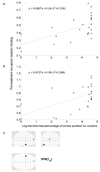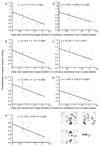Brain mu-opioid receptor binding predicts treatment outcome in cocaine-abusing outpatients - PubMed (original) (raw)
Brain mu-opioid receptor binding predicts treatment outcome in cocaine-abusing outpatients
Udi E Ghitza et al. Biol Psychiatry. 2010.
Abstract
Background: Cocaine users not seeking treatment have increased regional brain mu-opioid receptor (mOR) binding that correlates with cocaine craving and tendency to relapse. In cocaine-abusing outpatients in treatment, the relationship of mOR binding and treatment outcome is unknown.
Methods: We determined whether regional brain mOR binding before treatment correlates with outcome and compared it with standard clinical predictors of outcome. Twenty-five individuals seeking outpatient treatment for cocaine abuse or dependence (DSM-IV) received up to 12 weeks of cognitive-behavioral therapy and cocaine abstinence reinforcement, whereby each cocaine-free urine was reinforced with vouchers redeemable for goods. Regional brain mOR binding was measured before treatment using positron emission tomography with [¹¹C]]-carfentanil (a selective mOR agonist). Main outcome measures were: 1) overall percentage of urines positive for cocaine during first month of treatment; and 2) longest duration (weeks) of abstinence from cocaine during treatment, all verified by urine toxicology.
Results: Elevated mOR binding in the medial frontal and middle frontal gyri before treatment correlated with greater cocaine use during treatment. Elevated mOR binding in the anterior cingulate, medial frontal, middle frontal, middle temporal, and sublobar insular gyri correlated with shorter duration of cocaine abstinence during treatment. Regional mOR binding contributed significant predictive power for treatment outcome beyond that of standard clinical variables such as baseline drug and alcohol use.
Conclusions: Elevated mOR binding in brain regions associated with reward sensitivity is a significant independent predictor of treatment outcome in cocaine-abusing outpatients, suggesting a key role for the brain endogenous opioid system in cocaine addiction.
Published by Elsevier Inc.
Figures
Figure 1
Association of regional mOR binding before treatment and overall percentage of urine specimens positive for cocaine during the first month of treatment. Pre-treatment mOR binding in the (A) right middle frontal gyrus, and (B) left medial frontal gyrus shows a significant positive correlation with percentage of urine specimens positive for cocaine. See Table 2 for statistics. Lines are least squares best fit to data points. Display threshold for mOR binding is p<0.005 (uncorrected); cluster size k>50.
Figure 2
Association of regional mOR binding before treatment and duration (weeks) of longest abstinence from cocaine achieved during treatment. Pre-treatment mOR binding in the (A) left middle temporal gyrus extending to the left sub-lobar insular gyrus, (B) right middle temporal gyrus, (C) left medial frontal gyrus, (D) right middle temporal gyrus, (E) left middle frontal gyrus, (F) left anterior cingulate gyrus, and (G) right middle frontal gyrus shows a significant negative correlation with the duration of longest abstinence achieved during treatment. See Table 3 for statistics. Lines are least squares best fit to data points. Display threshold for mOR binding is p<0.001 (uncorrected); cluster size k>50.
Comment in
- Opioid-dopamine interactions: implications for substance use disorders and their treatment.
Volkow ND. Volkow ND. Biol Psychiatry. 2010 Oct 15;68(8):685-6. doi: 10.1016/j.biopsych.2010.08.002. Biol Psychiatry. 2010. PMID: 20888455 Free PMC article. No abstract available.
Similar articles
- Brain mu-opioid receptor binding: relationship to relapse to cocaine use after monitored abstinence.
Gorelick DA, Kim YK, Bencherif B, Boyd SJ, Nelson R, Copersino ML, Dannals RF, Frost JJ. Gorelick DA, et al. Psychopharmacology (Berl). 2008 Nov;200(4):475-86. doi: 10.1007/s00213-008-1225-5. Epub 2008 Sep 2. Psychopharmacology (Berl). 2008. PMID: 18762918 Free PMC article. - Imaging brain mu-opioid receptors in abstinent cocaine users: time course and relation to cocaine craving.
Gorelick DA, Kim YK, Bencherif B, Boyd SJ, Nelson R, Copersino M, Endres CJ, Dannals RF, Frost JJ. Gorelick DA, et al. Biol Psychiatry. 2005 Jun 15;57(12):1573-82. doi: 10.1016/j.biopsych.2005.02.026. Biol Psychiatry. 2005. PMID: 15953495 - Differential response to IV carfentanil in chronic cocaine users and healthy controls.
Minkowski CP, Epstein D, Frost JJ, Gorelick DA. Minkowski CP, et al. Addict Biol. 2012 Jan;17(1):149-55. doi: 10.1111/j.1369-1600.2010.00256.x. Epub 2010 Nov 4. Addict Biol. 2012. PMID: 21054687 Free PMC article. - Mixed κ/μ partial opioid agonists as potential treatments for cocaine dependence.
Bidlack JM. Bidlack JM. Adv Pharmacol. 2014;69:387-418. doi: 10.1016/B978-0-12-420118-7.00010-X. Adv Pharmacol. 2014. PMID: 24484983 Review. - Bouncing back: Brain rehabilitation amid opioid and stimulant epidemics.
Stewart JL, May AC, Paulus MP. Stewart JL, et al. Neuroimage Clin. 2019;24:102068. doi: 10.1016/j.nicl.2019.102068. Epub 2019 Nov 5. Neuroimage Clin. 2019. PMID: 31795056 Free PMC article. Review.
Cited by
- Age-dependent and strain-dependent influences of morphine on mouse social investigation behavior.
Kennedy BC, Panksepp JB, Wong JC, Krause EJ, Lahvis GP. Kennedy BC, et al. Behav Pharmacol. 2011 Apr;22(2):147-59. doi: 10.1097/FBP.0b013e328343d7dd. Behav Pharmacol. 2011. PMID: 21358324 Free PMC article. - The Effects of Naltrexone on Subjective Response to Methamphetamine in a Clinical Sample: a Double-Blind, Placebo-Controlled Laboratory Study.
Ray LA, Bujarski S, Courtney KE, Moallem NR, Lunny K, Roche D, Leventhal AM, Shoptaw S, Heinzerling K, London ED, Miotto K. Ray LA, et al. Neuropsychopharmacology. 2015 Sep;40(10):2347-56. doi: 10.1038/npp.2015.83. Epub 2015 Mar 24. Neuropsychopharmacology. 2015. PMID: 25801501 Free PMC article. Clinical Trial. - Prefrontal Cortical Opioids and Dysregulated Motivation: A Network Hypothesis.
Baldo BA. Baldo BA. Trends Neurosci. 2016 Jun;39(6):366-377. doi: 10.1016/j.tins.2016.03.004. Trends Neurosci. 2016. PMID: 27233653 Free PMC article. Review. - The opioid receptors as targets for drug abuse medication.
Noble F, Lenoir M, Marie N. Noble F, et al. Br J Pharmacol. 2015 Aug;172(16):3964-79. doi: 10.1111/bph.13190. Epub 2015 Jun 26. Br J Pharmacol. 2015. PMID: 25988826 Free PMC article. Review. - The contributions of cognitive neuroscience and neuroimaging to understanding mechanisms of behavior change in addiction.
Morgenstern J, Naqvi NH, Debellis R, Breiter HC. Morgenstern J, et al. Psychol Addict Behav. 2013 Jun;27(2):336-50. doi: 10.1037/a0032435. Epub 2013 Apr 15. Psychol Addict Behav. 2013. PMID: 23586452 Free PMC article. Review.
References
- Knapp WP, Soares BG, Farrel M, Lima MS. Psychosocial interventions for cocaine and psychostimulant amphetamines related disorders. Cochrane Database Syst Rev. 2007;3 CD003023. - PubMed
- Poling J, Kosten TR, Sofuoglu M. Treatment outcome predictors for cocaine dependence. Am J Drug Alcohol Abuse. 2007;33:191–206. - PubMed
- Unterwald EM. Regulation of opioid receptors by cocaine. Ann N Y Acad Sci. 2001;937:74–92. - PubMed
Publication types
MeSH terms
Substances
LinkOut - more resources
Full Text Sources
Medical
Research Materials

